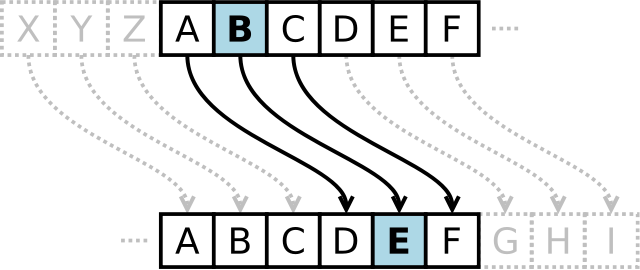
Cryptography
From Ancient Ciphers To Modern Encryption
The world of cryptography is a fascinating realm, where secret codes and hidden messages hold the key to unlocking mysteries and securing information. Cryptography has played a vital role in human communication and security throughout history. Let’s delve into its intriguing evolution and explore its impact on our world.
Early Ciphers And Codes
The origins of cryptography can be traced back thousands of years to ancient civilisations such as those of Egypt and Mesopotamia. In those times, simple substitution ciphers and hieroglyphic codes were used to transmit messages securely. One of the most well-known examples is the Caesar cipher (illustrated above), named after the Roman Emperor, who employed a shift-based substitution cipher to protect military communications.
A Renaissance In Cryptography
During the Renaissance, cryptography became more sophisticated, with the emergence of polyalphabetic ciphers (a cipher that uses multiple substitution alphabets) and the introduction of frequency analysis. Italian polymath Leon Battista Alberti invented the Alberti cipher disk, a mechanical device that allowed for the encryption and decryption of messages. These advancements marked a significant shift in complexity and paved the way for future developments.
The Enigma Machine
The 20th century witnessed remarkable breakthroughs in the field. During World War II, the Enigma machine, a complex encryption device used by the German military, presented a formidable challenge to Allied code-breakers. However, the efforts of code-breaking teams such as Britain’s Bletchley Park, led by Alan Turing, ultimately cracked the Enigma code, providing crucial intelligence and contributing to the Allied victory.
Advent Of The Digital Age
The advent of computers brought forth new possibilities in cryptography. In the 1970s, the Data Encryption Standard (DES) was developed as a widely used encryption algorithm. However, as computing power increased, DES became vulnerable to brute-force attacks. This led to the development of more robust encryption algorithms, such as the Advanced Encryption Standard (AES), which remains a cornerstone of modern cryptography. The rise of the internet and digital communication presented new challenges and opportunities for cryptography.
Secure communication protocols like SSL (Secure Sockets Layer) and TLS (Transport Layer Security) became essential for safeguarding online transactions and protecting sensitive data. Public-key cryptography, introduced by Whitfield Diffie and Martin Hellman in the 1970s, revolutionised secure communication by using asymmetric key pairs.
Cryptography continues to evolve rapidly in the digital age. Blockchain technology, used in cryptocurrencies like Bitcoin, relies heavily on cryptographic principles to secure transactions and maintain the integrity of the distributed ledger. Zero-knowledge proofs and homomorphic encryption are among the cutting-edge cryptographic techniques being explored to enhance privacy and security in an increasingly interconnected world.
The fascinating world of cryptography combines mathematics, computer science, and the pursuit of secrecy. From ancient times to the present day, cryptography has shaped the flow of information, safeguarded secrets, and enabled secure communication. As we embrace an era of increasing digitisation, the importance of cryptography in protecting privacy, securing data, and ensuring trust cannot be overstated.